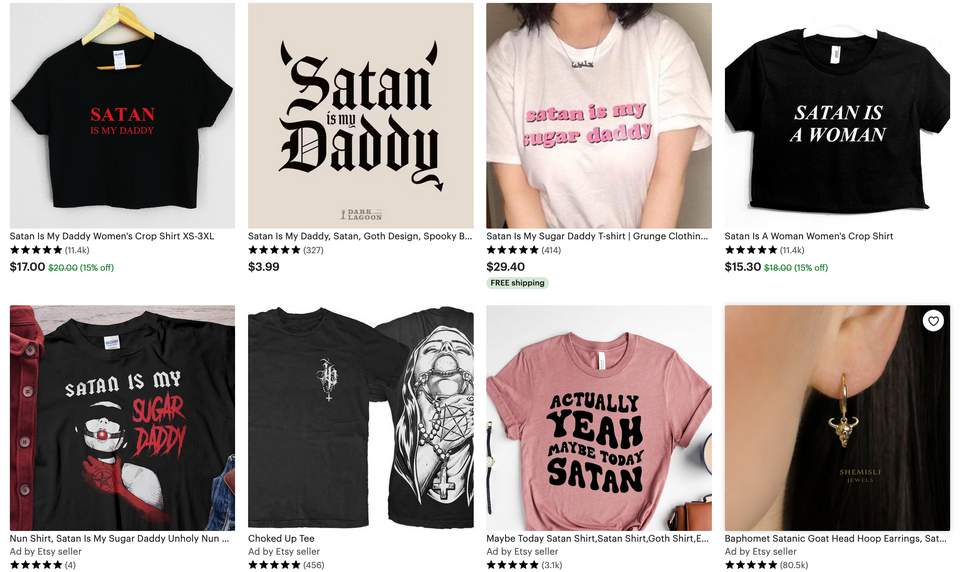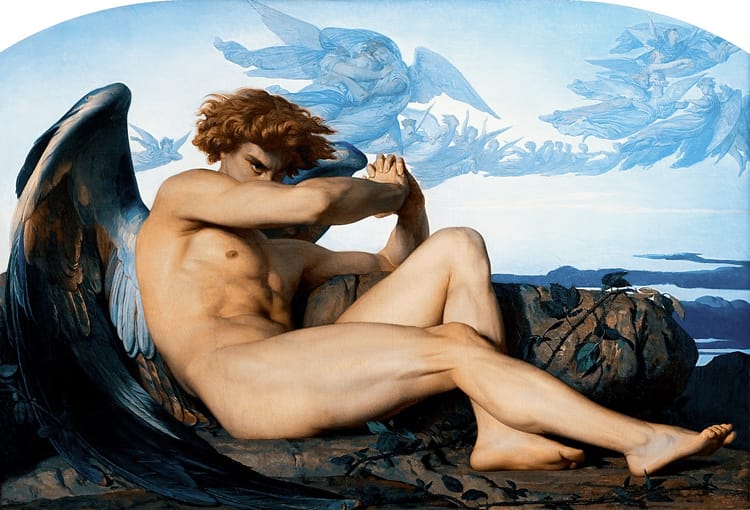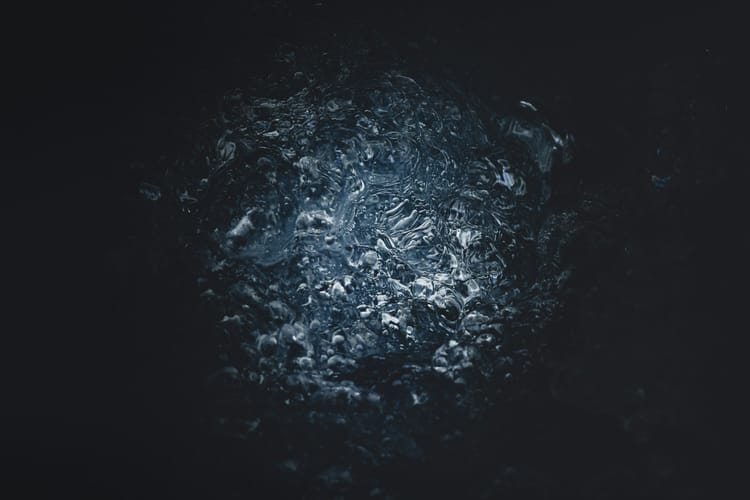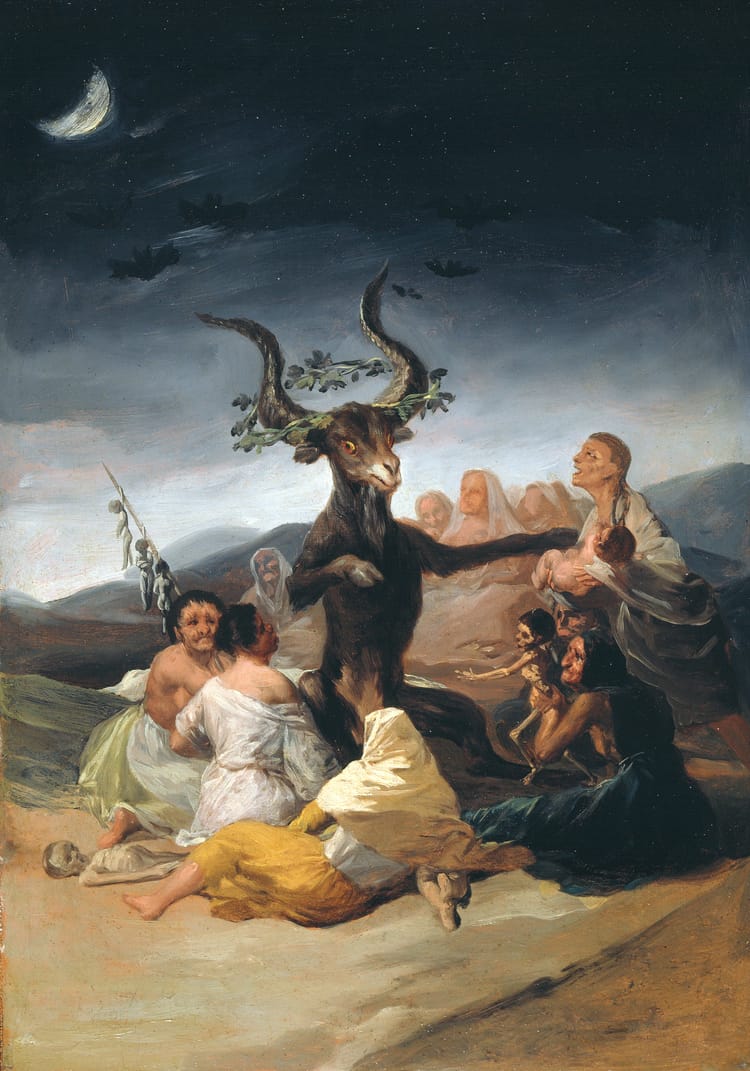New Moon: Mass market satanism

It's Friday. Hello. I'm writing up something very long and extra footnoted that I've been puzzling over for a while, perhaps ever since I became a satanist in 2017. It's a matter that may not be relatable to everyone reading this, but it could be to some; and I feel like I have to think about it because of how, although nobody is tallying raw numbers of satanists in global or even anglophone culture, I can't shake the sense that I signed the Devil's book during the rising of a strange wave of other people doing the same thing... or at least a wave of people consuming merchandise that suggests a friendliness toward the idea of signing the Devil's book, with numerous businesses of varying sizes then eagerly pumping out more fodder for the 21st century Satan-signaling crowd.
What's the real story: a satanic awakening followed by a consumerist trend, or a satanic awakening built upon a consumerist trend?
I pose this a bit facetiously; I don't really think the answer is one or the other. Though the consumerist trend feels objectively obvious to me, without statistics my only sense of a "satanic awakening" is rather subjective and entrenched in one very particular, fairly online milieu that I inhabit. So I'm not going to try and address whether the trend or the awakening came first; what's important is that assuming the satanic awakening is somewhat of a concrete phenomenon, then it's interlaced with and underpinned by the consumerist trend in some way. As I'll get to in a little while, I'm reasonably convinced that on the whole, less people buy satanic-themed merchandise from my position (that of actually, literally practicing a satanic religion) and more people do it from a different position. However, I don't want to imagine myself an incorrupt, unholier-than-thou figure, as I completely believe I'm part of whatever wave has risen. My satanism surely emerged with the help of some external influences, and teasing out whether it has some "pure" root is immaterial to how seriously I take the practice today.
So I haven't been fretting over that particular aspect. The real puzzle I've been facing is how to feel about mass market satanism, now that I'm at whatever point I've reached in my satanic practices. But before I let myself really venture into that, the above paragraph sent me into some undefined weeds already — so let me back up.
What I mean by a satanic awakening: I can find Satan all over the place
A recurring focus of my New Moon posts has already been satanism, prodded at from different angles. What I haven't really touched on beyond a few throwaway remarks has been just how popular satanic sentiments seem to have become within contemporary witchcraft, compared to decades past.
To begin at the beginning of what we call witches, it remains a matter of fierce debate and personal interpretation as to whether the English word witch always originally implied worship of or service to the Devil. I find arguments both for and against this possibility; and since words' meanings are always fluid, the safest answer to, "Does a witch implicitly serve Satan?" is probably, "It depends," hence why I prefer to state that I'm specifically a satanic witch, versus alternatives. But for those unfamiliar with why I'd have this reasoning, I will break down the arguments.
The word witch has evolved a couple times from the Old English wiċċe (feminine) or wiċċa (masculine) and verb form wiċċian.[1] The main translation I can find for that verb is "to practice sorcery," which seems to track with the earlier Proto-Germanic *wikkōną which gives us other West Frisian wikke (“to foretell, warn”), Dutch wikken (“to dowse, divine”), and Low German wicken (“to soothsay”). So there may have been some particularly divinatory, prophetic focus for the Old English concept of wiċċecræft[2] — and this would align with what pre-Christian Germanic cultural spheres demonstrated of a special class of female oracular seers, such as the Norse vǫlva. On this raw etymological basis, it would be easy to conclude that witch must refer to something like a vǫlva among the pagan Angles and Saxons.
There's just one problem: the documented Old English word for explicitly talking about such a female seer is either hellerune or hægtesse, among other options — none of which share any common derivation with the wiċċ- stem. So at some point prior to the evolution of Middle English, hellerune etc. was abandoned. Therefore it seems necessary to consider that this shift was an outcome of the early English people Christianizing, and that a wiċċe/a was some previously less-used word that became a common pejorative, because I've only ever run across the earliest English uses of witch and its etymological ancestors in negative contexts.
I strongly suspect that witch became a word in modern English almost exclusively through a Christian framing, and with that comes the Christian concept that sorcery, i.e. witchcraft, is achieved through a pact with the Devil. This does not mean all magic has always been rejected by Christianity (quite the opposite) but that in some Christian cultural linguistic spheres, including that of English, if someone in bygone centuries performed "good" magic then they wouldn't be called a witch at all.[3] Conversely, even if somebody had absolutely no interest in Devil worship, if they were persecuted for "being a witch" — never mind whether they practiced any magic at all — it was a virtual guarantee that the very word witch being thrown at them implied the Devil's involvement.
Unsurprising, then, that once the first 20th century witchcraft movements like Wicca were underway, there was an urge for witches to be distinguished from satanists. The specific, accusatory concept of satanists already existed from a century or two before, and out of the same occult spheres that birthed Wicca we also find the origins of modern satanism as a self-identified tendency; but as self-identified witches established themselves, it would have both minimized controversy and spoken to the concept of witchcraft as a pagan, pre-Christian belief system (regardless of historical accuracy) if the Devil were excluded from witchcraft in favor of different divinities. Feminist evolutions in the 70s (such as through the Reclaiming tradition, or Dianic Wicca[4]) also centered more and more self-described witches' worship around the Goddess; by the Satanic Panic of the 80s, it then seemed particularly incumbent for anglophone witchcraft to avoid satanic associations. Come the late 90s, this effort of dissociation seems to have born fruit, as popular media depictions of witches also emphasized the witches' moral stance against all things infernal. In Buffy the Vampire Slayer, a witch can become evil through "magic addiction" but she always seems to call upon deities of ancient polytheistic traditions, and the most virtuous witches are actively involved in surpressing the forces beneath the Hellmouth; in Practical Magic, Sandra Bullock's character is driven to emphatically promise, "There's no Devil in the Craft."
After all this recent history, though, I am constantly struck by the feeling that the pendulum has started swinging in the other direction — and this is the satanic awakening I'm talking about. To some extent it's not an awakening just within witchcraft, as the Satanic Temple (which is not a witchcraft tradition) has gained major media visibility over the past decade, and there are new explicitly left-wing, theistic satanist organizations like one that I'll describe in a later section; likewise although past posts of mine have repeatedly pointed to Robert Eggers' The Witch as an inflection point for what's been happening now, I should note that Eggers (and probably most other people who worked on the film) self-describes neither as a witch nor as a satanist. But besides how nowadays it seems a little more common for laypersons to recognize and flirt with satanisms outside the LaVeyan variety, I'm particularly encountering people who call themselves witches or at least witchy — most of all within or adjacent to my beloved goth subculture — and who worship the Devil or are intentionally exploring some kind of place for him/them.[5]
The examples on my mind are too numerous for me to list in full, and in some cases I would just be listing personal friends of mine from whom I can't cite anything precise. But one example of a witch who's a fellow writer is Gemma Gary, whose books I still need to read but whose ideas interest me greatly — a framing of traditional witchcraft not in the capitalized sense linked with Robert Cochrane[6], and not actually professing an unbroken line of ancestral tradition, but instead traditional in the sense of newly constructing itself out of known British folk traditions regardless of their specific age or identification with "paganism" or the actual word witch. My understanding is that in her constructive process, Gary has embraced the Devil insofar as he was a significant figure for Cornish magic-workers; this is paralleled by the embrace of "the Witch's Devil" by Cymric witch Mhara Starling, whose work I referred to in an earlier footnote. I've also noticed less prominent cases but all in all it feels as if witches who work with the customs and land relations of Britain, or wider Celtic and Germanic animism, are increasingly cognizant of how Satan's assigned connection to witchcraft isn't something to shun, rather to intentionally engage.
I'm less familiar with what self-described witches working in other cultural spheres are doing around Satan, and especially unfamiliar with what more eclectic witches pulling from a maximal number of traditions are doing. However, even a cursory perusal of the online pagan and/or occult communities I frequent does show me that this potential satanic awakening isn't absolutely restricted to my own sphere. So many online witches, chaos magicians, and more love to engage with the demonology found within The Lesser Key of Solomon, etc., and to treat it not as a Christian mastery of infernal beings but as a pro-satanic activity.
And while I may be misremembering, I believe that the Devil has always played a more openly prominent role in modern witchcraft and occultism in certain cultures where these practices were not so founded in Wicca. I've read, for instance, that satanism has long been a notably popular trend for French occultists, contrasted with British or American ones, so I can only imagine that as anglophone paradigms hegemonically propagate themselves through the internet, an anglophone satanic awakening in witchcraft would maybe find a ready audience in France, intensifying something that was already there. I'd love to learn more about this, just as I continue to periodically learn more about what might be going on with the decades-old satanic undercurrents in the black metal scenes of Scandinavia (and by this point many other places worldwide).[7] But in any case, nowadays within my own limited view I simply see far more of Satan in ritualism, especially in witchcraft, than I ever used to when I first started delving into occult/esoteric and pagan/animist practices in the early 00s. Wherever I look among my peers, Satan leaps up.
What I mean by a consumerist trend: I can buy Satan all over the place
Echoing all the above, here's what I wrote over the winter in a post about tarot:
... like astrology, tarot is extremely visible these days — a major token of what I toy with calling the New Witchery. New Witchery is, cynically speaking, a phenomenon branded to no one company but still commercialized: an intersection of larger companies discovering a market for a "darker" update of #content that was packaged 10-30 years ago as New Age, and of independent creatives finding distribution for either that same material or its more authentic counterpart. This phenomenon comes with art styles, fonts, and motifs that like it or not, I and other goths and ritualists can easily recognize and these days are rarely exempt from consuming; as a crucial distinction from the New Age age, Mother Goddess Moon Womb Magic merchandise and books are still available, but "there's no Devil in the craft" is out — the Devil is welcome everywhere. You can get underpants reading "Satan is my Daddy" for $15 from multiple online retailers.
Now, it's been long enough since I wrote that, I can't tell you if I had really found a specific pair of "Satan is my Daddy" for exactly $15, but looking again today, through the clothing company Killstar I can certainly find (for $29.99) a sexy, sheer bodysuit emblazoned with the Sigil of Lucifer, inverted pentagrams, inverted crosses, and the alchemical symbol for sulfur that is heavily associated with the Church of Satan's use today. For $49.99 through the same company I can also buy a long-sleeved t-shirt with colorful art and the text "Devil's Advocate." Meanwhile, if I visit Blackcraft's webpage, for $38.99 I can order a pair of gym shorts emblazoned with the Church of Satan's Sigil of Baphomet on the front and the number 666 on the back.
These are just a couple of corporate examples, but I raise them because a) I think they're among the more visible New Witchery (or Nu Goth) clothing companies operating today, b) I do actually own some clothing from these companies, a point which I'll get back to later, and c) while Killstar positions itself as a more general gothic lifestyle brand that freely incorporates all manner of witchy aesthetics, satanic or not, by comparison Blackcraft presents itself as exceptionally Satan-oriented and sells many items themed around a concept of satanism as rejection of religion, belief in oneself rather than in any gods, and the Devil as a transgressive metaphor. In other words, Blackcraft not only promotes the imagery of Satan but even promotes something close to a satanic ideology that's exceptionally suited for atheistic satanists of the Church of Satan and Satanic Temple molds.
I've aired some of my grievances with those groups before, and I will soon do so again. But first, although I've raised the likes of Killstar and Blackcraft for examples of a satanic consumerist trend, I want to also observe that the trend isn't restricted to relatively large-scale fast fashion. You can also open up Etsy and find thousands and thousands of relevant search results if you look for "satanic clothing," as well as for "satanic jewelry," "satanic decorations," and so on. Some of these items are still mass-produced in that their designs are created by private individuals but then manufactured on industrial equipment by a third party; some are handmade works created in much smaller batches or even as one-of-a-kind pieces; and still others are plagiarized, roboscraped chum from the former categories. Whatever the case may be, New Witchery visual aesthetics abound across these sellers' products, putting them on a continuum with larger companies.
And just as there are far more examples of larger companies selling satanic-themed merchandise than Killstar and Blackcraft, there are far more online marketplaces for small satanic merch operations than just Etsy. I've only named what I'm most familiar with. If I don't go to a specific website right away and just search for "satanic ___" through Google, I'm readily inundated with countless alternatives. I can buy Satan from retailers situated on most if not all continents.
"Buying Satan" is of course a metaphor. If I buy a mass-produced shirt with a very devilish looking figure on it and some satanic flavor text, I'm not buying the actual entity Satan unless I happen to believe he can inhabit that object — which I don't believe, or at least not without me doing some personal work to consecrate the object and make it into a sacred idol.[8]
But if within this consumerist trend I can "buy Satan" without really buying him, what is it that I'm not buying? I have to finally lay out a fuller explanation of my own concept of Satan.
Theistic, leftist satanism
Since I've written shorter descriptions before, or defined my satanism in opposition to other satanisms, if you haven't read this post I would encourage doing so; I also wrote a more recent post for paid readers here. Either way, I'm now going into more detail.
The animist side of my rites uses Satan as an extended stand-in for quite a few ancient gods from polytheistic animisms; the ceremonial magic side of my rites approaches Satan as the biblical Adversary, the Miltonian fallen angel, the inverse of God-the-Father, and himself the father of the Antichrist. Whatever the case, my experience of Satan is certainly as a real god; by this I mean he's not a figure of speech or a symbol for every human being assuming their own personal godhead.
In this respect I would increasingly qualify myself as a theistic satanist, not an atheistic one. This is a little odd for me to write, because if you were to ask me if I believe Satan exists as an entity capable of manifesting in a way that can be perceived with any of my five senses, I would say no. Also, I don't worship Satan as a creator figure, and any authority I assign to him is only an authority I grant through my own submission to him; it's a consensual power exchange dynamic rather than something mandated by Satan's sheer divinity. As these kinds of distinctions contrast with what people in culturally Christian contexts describe as "believing in a god," I used to and still sometimes do call myself "an atheist from certain angles." But as I write this post, I feel obliged to more directly acknowledge that the barriers between atheism and theism are not actually clear cut when you comprehensively examine non-Christian religions, especially animist religions. With the right definition of what a real god is, I have one.
And this god is also of the left, using Left Hand Path as a designator for more than something like the Dark Side of the Force[9] — the rules and laws to break are those made by our oppressors. My satanism necessitates the destruction of nonconsensual authority, thus it demands opposition to capital, opposition to state, opposition to empire and colony, opposition to patriarchy, opposition to white supremacism, and opposition to any other hegemony I can think of.
I'm not alone in this left-anarchist interpretation of the Devil; it can be found throughout history in cases such as Percy Bysshe Shelley's satanic flirtations. It's also what made the Satanic Temple mildly attractive to me when I first learned of it — unlike the Church of Satan, whose ideology has always transparently lended itself to repressive, reactionary ideas, Ayn Rand's Objectivism turned ironically into an atheist religion. The Satanic Temple's apparent ideology struck me as perhaps more just center-liberal than actually leftist, but at least the organization seemed to be antifascist and invested in pointedly bringing down the Christian right wing.
Ha, well.
Sadly, with every passing year I've learned enough unsavory details of the Satanic Temple that although I'll never regret visiting their headquarters for a very satisfying photograph with their notorious Baphomet sculpture, I'm glad that I followed my instincts to never become an actual member. For one thing, the organization's choice to still be atheistic like the Church of Satan is telling — because they really don't seem to offer anything of (spi)ritual value, only legal cases. It's just the ACLU with shock imagery thrown in. For another thing, their progressivism seems like more of a posture than a reality, contradicted by statements that the charismatic leader founder makes behind the scenes and by the kinds of behaviors that are tolerated within the organization (and punishments inflicted on members who offer criticism). And in summary: if satanism is meant to oppose nonconsensual authority and hierarchy, then shouldn't the last thing that any satanist does be... to start a unilaterally operated organization?
To that end, while I remain steadfastly committed to near-solitary practice, I've been somewhat interested in the development of a theistic, leftist organization called the Luciferian Dominion, though as of this writing their website seems to be offline and I can only conclude that perhaps they've disbanded. That's a shame, because with the major players of anglosphere satanic orgs seeming to link their atheism (needlessly) with accomplishing anything but leftist, liberatory goals, it would be magnificent to contrast this with either an atheistic satanism that makes good on its promise or — if atheism and leftist satanism are simply incompatible — a theistic satanic org that chooses the political left.
So far, I've found very few groups that show such a promise. Quite frankly, another reason I've sometimes hedged at saying I'm a theistic satanist is that most theistic satanism I've encountered is an utter nightmare I also want nothing to do with (see: the Order of Nine Angles and related phenomena I've mentioned in my other satanism posts).
What stops me from throwing up my hands and despairing of "being" a satanist is that since I wouldn't want to join a group founded by someone else and I wouldn't trust myself to safely establish and co-run a group even with very trusted people, I've long made peace with the idea that although my satanism urges communalism, such communalism is to be found through organically recovering animist social traditions among kindred spirits — not through constructing a fixed structure and expecting people will just come out of the woodwork to find it. My disappointment about most satanic organizations out there isn't that I can't find my home, but that their issues compel me to continuously spend time distancing myself from them.
Their existence frustrates me; however, they will always be quite fringe. So what would frustrate me even more as a satanist would be something satanically-tinged that was much more pervasive and that I would therefore need to spend much more time negotiating my beliefs against. This brings me at last to what I've really wished to tackle in today's post.
The sacredly profane vs. the profanely profane
When I started writing this, I asked how I feel about mass market satanism.
My first feeling is a slow-mounting exhaustion. I encounter so many people who, like me, are happy to display tokens of having a satanic worldview, but with so many of those tokens coming out of a pop cultural butter churn, there are too many opportunities for irony, insincerity, and vapidity for me to easily see where things that suggest authentic satanic awakening end and things that suggest consumerist trend begin. The underlying ethos of consumerism and wider capitalism is that everything in creation is fair game to be cut up and spliced and repackaged and spat back out, divorced from origin. Nothing is sacred. On a religious level, this has damaged indigenous animist practices the most palpably, but to some degree I suspect the best way to mount resistance to the maw of capital devouring certain religions is to mount resistance to that maw devouring any religions — let the sacred remain sacred!
Whenever I have this feeling, it's then followed by some embarrassment. As Satan is inversive, subversive, often comparable to a trickster god, doesn't it do him a disservice to insist there's no room to have fun with his image? Isn't he less an utterly sacred figure than a sacredly profane figure? And some self-described satanists are so obviously pompous and drunk on their dark intensity — the edgelord problem — that at least their version of satanism is rightly parodied in popular media. If I were to put out some public plea for satanism to be treated with respect, I would grow quite self-conscious about presenting myself like the Alliance of Magicians on the show Arrested Development, a guild of painfully earnest stage magicians who insist their magic is real and operate under the slogan, "We demand to be taken seriously."
On the one hand, my reverence for Satan is very real, and the most important objects or tokens I've collected that speak to my satanic beliefs are very special, uniquely made things — like one of my tattoos, and a painting over my altar space. On the other hand, if I took a look at some of my mass-produced satanic merchandise impulse buys from years past — a couple of silly shirts, a Baphomet plushie, that sort of thing — I can't bring myself to get rid of them because they're just not reverent enough.
But in the end, these days I still feel very challenged when I'm looking for new clothes (not yet being in a position to make them myself or order a lot of custom work from individual tailors) or other key forms of self expression. My overall style remains goth, through and through, so I'm endlessly confronted with satanic imagery in keeping with the New Witchery, and sometimes I really just want something with a satanic motif so I go deliberately looking for it and will, in all likelihood, find something I enjoy; and yet I've grown pickier and pickier. If Satan is the sacredly profane, I want to still maintain a distinction between that and the profanely profane. If Satan does not need constant reverence, I want to still give him a weight and form that consumerism strips away.
He is the accuser from the past, and he is the salvation for the present — or, if there is a future, for the future. He saves not from sin but from the godmachine. To cede all sense of him to the godmachine, to make him merely a brand, logo, and slogan, is a defeat I can't conscionably support.
But while it would be tempting for me to leave this post right here, the story is also more complicated than that.
Turning from the cynical to the devotional
So far, I've largely described mass market satanism's sellers as being essentially cynical in intent. Whether they created a demand or simply answered one, now that there's an audience for those hypothetical "Satan is my Daddy" panties the panties will continue to be manufactured for the sake of profit. People can slap inverted pentagrams on whatever they like, with no ritual intention behind it, because they've learned someone will buy it.
But what about satanists who take advantage of a trend because they realize someone would finally be interested in supporting their creation of genuine devotional arts and crafts? And what about people who are self-described satanists and whose art is enormously financially successful? Well, in all cases I still care about the quality of the art and the personality of the artist, but for instance I love the band Ghost and its frontman Tobias Forge; nowadays some fans claim he's sold out, which I would have to go far beyond the scope of this one post to really untangle, but the summary of my stance is that although I have the softest spot for how Ghost used to sound, it's all good music, and it's all satanically tinged, and I completely believe in the authenticity of Tobias' expressed satanism.
As I said at the outset, I think (though my perspective is limited) that we're in the middle of a real satanic awakening among actual witches and other ritualists. Since some of those people are also artisans, creative types, whatever you'd like to call us — as a particular mindset grows a little more mainstream, even though that enables capitalism to appropriate it there's also the possibility for devoted practitioners to more publicly express their satanism, including through making things that people can wear or display in their homes, and getting paid so that they can make a living. There's even the possibility that while maybe small-operation, handmade expressive items are probably the most ethical thing for me to spend my money on, using a bit of aesthetic signaling from any source can be a means of connecting with other satanists I might like to talk with, even if the actual signal to noise ratio remains somewhat dubious.
I don't mean that satanists should be seizing this moment in order to proselytize, since I'm against proselytism; but I do mean that the proliferation of satanic aesthetic signaling is really from two related but different things going on at once. There are more and more people who feel genuinely drawn toward the Devil, especially from a similar left-wing angle as my own — and then there is the culture machine that notices a real hunger and tries to profit from it. Given that you can find an array of merchandise that equally satisfies the urge to treat Satan with joyful silliness and the urge to treat him ultra-seriously, it does remain all too easy to give in to that culture machine in some way. So where do I truly wish to draw the line?
The signifier is not the signified
The point where I think I've decided we need to resist, beyond just favoring smaller or more authentic sellers, is that buying things does not amount to real satanic practice. Signaling my satanism is not doing my satanism. Yes, choosing an aesthetic to broadcast my practices can be a way to find other practitioners, and choosing an aesthetic for my private life can be a way to ground myself in a meaningful identity — but simply buying things and wearing things and instagramming things is not going to have the same effect as performing ritualized activities.
The consumerist myth that equates these things is what I'm really tired of, more than the question of reverence vs. irreverence. My oath is signed in blood on a page that almost no one else will ever see, and my rites bring me peace and power in a manner that no retail therapy ever could. Besides my satanism's actual opposition to consumerism, there is just no meaningful, pro-ecological, land-connected life to be found down the consumerist road, regardless of what exact kind of ritualist practice anyone is hoping to pursue.
Of course, while it's easy enough for me to distinguish between signaling satanism and actually practicing it, Christian fascism doesn't particularly distinguish at all, which adds a unique layer of risk to signaling satanism regardless of sincerity. But that is, needless to say, a whole second chapter to discussing mass market satanism, which I'll have to address some other week.
[1] The ċċ sound in Old English would be like the "tch" in witch. So the pronunciations here are respectively "witch-eh," "witch-ah," and (I think) "witch-an." And note also that in Old English the -e ending is feminine whereas the -a ending is masculine. So while I'm not sure how many Wiccans these days are specifically invested in claiming an ancient pedigree, a truly ancient way to pronounce Wicca would not be with the hard "k" sound; and a more "female-centering" name might be Wicce. (Apologies to Wiccans, I have nothing against them and am always up front about owing many aspects of what I do to Wicca.)
[2] Though curiously, the Proto-Indo-European root may have been *weyk (“to consecrate, separate”). Make of that what you will.
[3] I'm currently reading Mhara Starling's Welsh Witchcraft wherein she points out that in the Cymric language there is no direct translation for witch apart from using the direct English loan word. Native Cymric concepts for magic users comprise at least several different words with varying positive vs. negative connotations; while Cymru was Christianized just like England, witch hunts rarely ever happened in the centuries to come, not just because Christianity was blended harmoniously with folk animism and intellectualized occultism, but perhaps even because the witches that English people were obsessed with uncovering really didn't become a culturally translatable concept in Cymru. I don't know how perfectly I buy this argument, as I wonder how to compare it with the startling violence and frequency of Scottish witch trials; then again, most of those were in the relatively anglicized Lowlands, and I would be at least the millionth person to remark upon the harmonious Catholic animism of Gaelic cultures.
[4] I do have something against Dianic Wicca: rampant transphobia and bodily essentialism.
[5] Here is my usual disclaimer that although the Devil is a male figure in my personal practice, a satanic figure of any gender can be just as potent for other people's practices if that suits them.
[6] For more on Traditional Witchcraft as a propagation of Robert Cochrane's Craft in contrast to the "false pedigree" Cochrane perceived in Wicca (while Cochrane himself nonetheless probably created his own rites instead of inheriting them), see Ronald Hutton's The Triumph of the Moon.
[7] Discussing satanism in black metal is so fraught and complex that I can't possibly dive into it in this already enormous post, especially because the movement precedes the current satanic awakening by a fair bit; and although I'm a black metal fan I would say I've ultimately only scratched the surface of what's out there so I'm not well-equipped to write about the genre. Obviously black metal's occasional marriage of satanism with fascism is a serious problem just like its occasional marriage of heathenry with fascism, but as those marriages occur outside of black metal as well, I would rather pick them apart in a more general way than concentrate on just one musical genre that not all fascists listen to.
[8] I believe that Satan generally manifests and expresses best through living, animate beings embodying him — not through inanimate things. But if my beliefs ever changed and I did want an idol that could capture Satan's very essence, I would probably prefer something individually, uniquely crafted. That's only me, though. If someone else wanted to personally consecrate a mass-produced item and call Satan into it somehow, so be it.
[9] The terms Left Hand Path and Right Hand Path more or less originate with Helena Blavatsky, whose thinking was extremely formative to contemporary Western-style occultism although she was unfortunately quite racist, while similarly the forms of "Eastern religion and mysticism" she introduced are — as far as I can tell — more her own interpretations than accurate renderings of Hindu, Buddhist, or other Dharmic religions. The Left vs. Right Hand Path is a dichotomy found within Tantra, among other traditions, but I can't speak to how well those original Sanskrit concepts have been translated. In any case, though, in modern occultist terms the Right Hand Path is crudely simplified as magic obeying the typical prescriptions of mainstream morality and generally adhering to strong ethical principles; the Left Hand Path is contrasted as magic that deliberately transgresses mainstream morality and may not have any ethics behind it at all, focused on violating taboos, especially around sexuality. As the rest of this post illustrates, I favor the Left Hand Path but only when opposition to the status quo is carried through to a logically left-anarchist, anti-authoritarian conclusion.
Thank you for reading. I hope that in some way, shape, or form these particularly focused yet extensive ramblings gave you something interesting to soak in for the weekend. Next week there will be quite a directional pivot to fresh discussion of my choice to treat homemaking as a ritual; after that, to coincide with discussion of Calan Awst/Lughnasadh I'm going to write up some thoughts about Celtic calendars — plural.





Member discussion